OTHER RESOURCES
Some of this information comes from the listings of Non-Prefixed and Non-Suffixed aircraft reviewed by me in the archives of the National Air & Space Museum (NASM), Washington, DC.
---o0o---
The definitive reference for early Lockheed aircraft is: Allen, Richard S. 1988. Revolution in the Sky: The Lockheeds of Aviation's Golden Age. Orion Books, NY. 253 pp.
---o0o---
THANK YOU!
YOUR PURCHASE OF THESE BOOKS SUPPORTS THE WEB SITES THAT BRING TO YOU THE HISTORY BEHIND OLD AIRFIELD REGISTERS
Your copy of the Davis-Monthan Airfield Register 1925-1936 with all the pilots' signatures and helpful cross-references to pilots and their aircraft is available at the link. 375 pages with black & white photographs and extensive tables
---o0o---
The Congress of Ghosts (available as eBook) is an anniversary celebration for 2010. It is an historical biography, that celebrates the 5th year online of www.dmairfield.org and the 10th year of effort on the project dedicated to analyze and exhibit the history embodied in the Register of the Davis-Monthan Airfield, Tucson, AZ. This book includes over thirty people, aircraft and events that swirled through Tucson between 1925 and 1936. It includes across 277 pages previously unpublished photographs and texts, and facsimiles of personal letters, diaries and military orders. Order your copy at the link.
---o0o---
Military Aircraft of the Davis Monthan Register 1925-1936 is available at the link. This book describes and illustrates with black & white photographs the majority of military aircraft that landed at the Davis-Monthan Airfield between 1925 and 1936. The book includes biographies of some of the pilots who flew the aircraft to Tucson as well as extensive listings of all the pilots and airplanes. Use this FORM to order a copy signed by the author, while supplies last.
---o0o---
Art Goebel's Own Story by Art Goebel (edited by G.W. Hyatt) is written in language that expands for us his life as a Golden Age aviation entrepreneur, who used his aviation exploits to build a business around his passion. Available as a free download at the link.
---o0o---
Winners' Viewpoints: The Great 1927 Trans-Pacific Dole Race (available as eBook) is available at the link. This book describes and illustrates with black & white photographs the majority of military aircraft that landed at the Davis-Monthan Airfield between 1925 and 1936. The book includes biographies of some of the pilots who flew the aircraft to Tucson as well as extensive listings of all the pilots and airplanes. Use this FORM to order a copy signed by the author, while supplies last.
---o0o---
Clover Field: The first Century of Aviation in the Golden State (available in paperback) With the 100th anniversary in 2017 of the use of Clover Field as a place to land aircraft in Santa Monica, this book celebrates that use by exploring some of the people and aircraft that made the airport great. 281 pages, black & white photographs.
---o0o---
YOU CAN HELP
I'm looking for information and unique photographs of this airplane to include on this page. If you have some you'd like to share, please click this FORM to contact me.
---o0o---
SPONSORED LINKS
HELP KEEP THESE WEB SITES ONLINE
FOR YOUR CONVENIENCE
You may NOW donate via PAYPAL by clicking the "Donate" icon below and using your credit card. You may use your card or your PAYPAL account. You are not required to have a PAYPAL account to donate.
When your donation clears the PAYPAL system, a certified receipt from Delta Mike Airfield, Inc. will be emailed to you for your tax purposes.
---o0o---
LOCKHEED VEGA NR105W
"The Winnie Mae of Oklahoma"
This is a famous airplane. There may be confusion about it, however, since there were three Lockheed Vegas named "Winnie Mae." In chronological order, the first Vega to be named "Winnie Mae", NC7954, was flown to the Davis-Monthan Airfield, Tucson, AZ twice by Wiley Post and once by Art Goebel. To see an image of this airplane, please follow this link to the Klein Archive of Aviation Photographs.
The second "Winnie Mae", NC/NR105W, is the subject of this Web page. This "Winnie Mae" is on exhibit at the Smithsonian National Air & Space Museum. The link takes you to the Smithsonian Web site and an excellent starboard profile of the airplane as it sits today. It is the "Winnie Mae" of greatest significance, since it flew around the world twice during the early 1930s, setting records each time. The third "Winnie Mae" was NC905Y. Please direct your browser to the links for further information.
Interestingly, another Register Lockheed Vega, NC898E, painted in "Winnie Mae" livery, is on exhibit at the Fantasy of Flight museum, Polk City, Florida. NC898E is being restored to flying condition as of the upload date of this page. Please direct your browser to the links, and the links there from, for additional information about NC898E. It never was officially named "Winnie Mae," like the others, rather it is just painted in its livery.
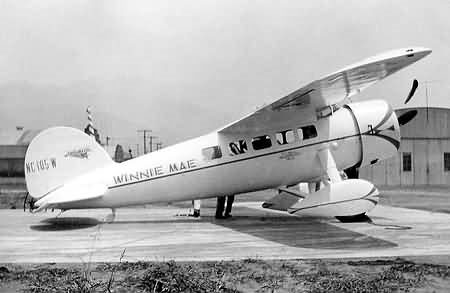 |
THE "Winnie Mae" is pictured at left courtesy of 1000aircraftphotos.com. NC/NR105W is S/N 122. It was manufactured during June, 1930. Several photographs of it are exhibited on Wiley Post's Web page, linked above. It is a six-place, single-engine, low-wing monoplane. It left the factory with a Pratt & Whitney Wasp engine, S/N 3088, of 450HP.
It sold originally to oil man F.C. Hall of Oklahoma City, OK on June 21, 1930. It was named "The Winnie Mae of Oklahoma." Winnie Mae was the owner Hall's young daughter. Hall hired Register pilot Wiley Post to prepare it for racing and fly it for him. During its short flying life, which ended in August, 1935 with its donation to the Smithsonian, NR105W became a different airplane than the one originally delivered to Hall. The reason for this is that it had many replacements of parts and structures due to accidents and wear, and many modifications for racing and long-distance flying. Read on for examples of these changes.
Immediately after its purchase it was placed in harness for racing and long-distance flying. According to information reviewed by me at the NASM (top left sidebar), it was licensed "NR," "restricted," for the Los Angeles to Chicago Air Race that was part of the National Air Races (NAR) in 1930. It was modified with an engine with a 10:1 supercharger, fitted with fuel tanks with 500 gallon capacity and certified to carry just the pilot. These changes were approved on August 21, 1930, just in time for the NAR, which were held August 23-September 1.
Wiley Post won this cross-country event handily in 9:09:04. Post and owner Hall won $7,500 for their effort. Post was in fast company during the race. Second place went to Art Goebel, and 3rd through 5th to Lee Shoenhair, William Brock and Roscoe Turner, respectively. They all flew Lockheeds.
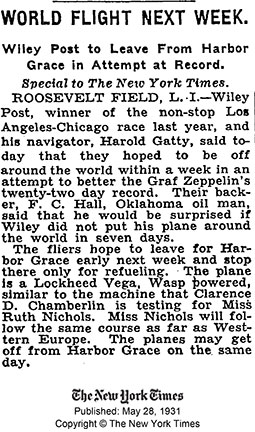 |
On September 18, 1930, the registration was changed back to "NC," and it was flown that way until May 9, 1931 when it was re-registered "NR," and certified to carry two people. It was fitted with nine fuel tanks, five in the wings and four in the fuselage, for a total of 550 gallons. This was in preparation for Post's round-the-world flight with navigator Harold Gatty (1903-1957). This flight took place from June 23 to July 1, 1931.
The flight took eight days 15 hours and 51 minutes, including four days, 10 hours and 8 minutes of actual flying time. They covered 15,474 miles. Technological innovations were aboard. A radio transmitter and receiver operating on 35.5 meters was installed on the "Winnie Mae," as were two aperiodic compasses, an artificial horizon and a drift meter of Gatty's design. Anticipation for the flight was published in The New York Times, May 28, 1931, right. Note mention of Register pilots Ruth Nichols and Clarence Chamberlin.
 |
One would think both Post and Gatty would be elated at the completion of their flight. It did set a significant record for the era. However, the article at left from The New York Times, November 22, 1931, implies otherwise in an interview with Post in Chicago, IL. Post show up as cynical regarding the adventure, stating, "Our flight didn't prove a thing."
He also sounds disillusioned that he and Gatty didn't realize more monetary value for their flight: a book or movie contract, for example. He implies, too, that other record setters experienced the same disinterest, with publishers and movie studios more interested in their bottom line than in the skills, performance and sacrifices of the fliers and aircraft. He dismisses the possibility of another flight with, "No, I'm not making any more flights. Whi should I? There is no flight left worth making. ... The day of money-making flights is past."
An interesting finding in this article is that there was already an intention to have the "Winnie Mae" placed for display in the Smithsonian. And we also discover that Post and Gatty were headed on a lecture tour, a paying activity that would not have been possible were it not for their flight.
Perhaps it was the grey, Chicago November day, or the Great Depression, or his lack of foresight, but there was still money to be made in aviation, and records to be set. It could have been a short memory, too, since he had won $7,500 just a year earlier at the NAR. And there was his second around the world flight, below.
Regardless, the NASM record shows that the airplane was sold to Wiley Post on January 12, 1932. Now we find NR105W landing at East St. Louis a day after Post took ownership, on Wednesday, January 13, 1932 at 4:35PM. Post was apparently solo, and he identified his destination as New York, NY. No reason was given for the flight.
A little over a year later, on February 5, 1933, NR105W was transferred to Fain & Post Drilling Company, Oklahoma City, OK. It was registered "NC" to Fain & Post. According to the NASM record, a few months later, on April 22, 1933, the airplane suffered an accident at Chickasha, OK. The pilot was Luther E. "Red" Gray. Damage occurred to the left landing gear and strut, the propeller was bent, a hole punched in the left side of the fuselage, two bulkheads were cracked and the wheel pants and engine cowling were bent. No injuries were reported for Gray.
Some repairs were made. The entire landing gear was rebuilt by Lockheed Aircraft Corporation, new belly fittings were installed and while they were at it, the horizontal stabilizer, elevators and rudder were rebuilt and a radio mast was installed. As well, the engine was overhauled with nine new cylinders and pistons, all new supercharger bearings, new magnetos and coupling gears, new ignition harness and the carburetor overhauled.
This accident must have been extensive, since additional repairs were performed and reported by Braniff Airways after the Chickasha accident. As of June 10, 1933, a complete half-fuselage was replaced, with some bulkheads replaced and others rebuilt and strengthened. The entire fuselage was re-covered with fabric, and the cockpit was rebuilt with all new control cables. The right wing tip was completely rebuilt and seven stringers were installed between the spars. The entire top side of the right wing was covered with new plywood. No windows were installed in the cabin except for the one above the emergency exit. Fuel tanks of 410 gallons capacity were installed.
With the extensive rebuild, "Winnie Mae" was now flown around the world again from July 15-22, 1933. This time Post was solo.The flight took seven days 18 hours and 49 minutes and covered 15,596 miles, just a hundred or so miles more than the 1931 flight.
That flight was not without hazards, however. Below, a photograph of NR105W after an upset in Alaska on the next to last leg of its return to New York.
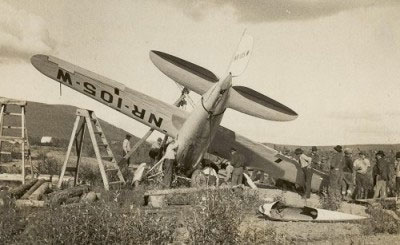 |
Curiously, the NASM record does not document the repairs made after this incident in Alaska. The photograph, left, shows the attitude of the airplane after it nosed over. Besides the propeller, the right landing gear and wheel pant, and right wing tip, appear damaged. This was a lot of damage to correct, essentially overnight.
Below, from The New York Times, July 21, 1933, an article describing that single incident Post had at Flat, AK near the end of his circumnavigation (see map). The photograph of his wife has us remember that for every record flight there were loved ones on the ground that waited. How must it have been for them?
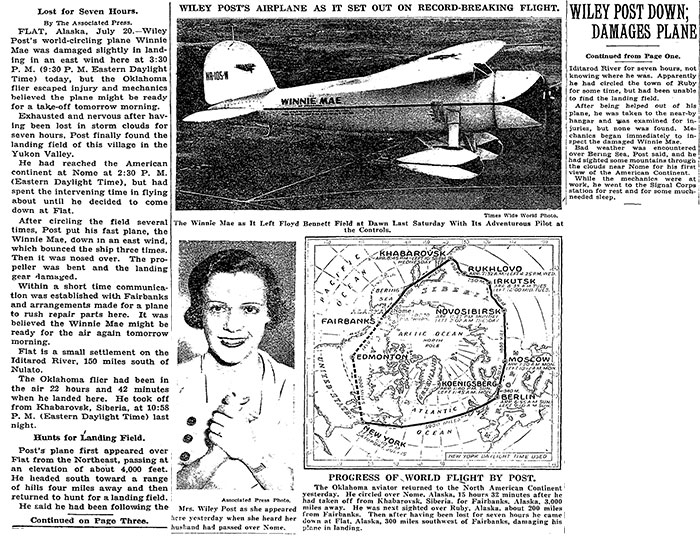 |
 |
Despite the one upset, technological innovations were also aboard this flight. Post worked with the Sperry Gyroscope Company to install and test a prototype autopilot. He also carried a radio direction finder, which allowed him to home in on radio transmitter stations on the ground. Given these innovations, Post's earlier statement, in the November, 1931 article above, seems a little premature, viz., "It is silly to say that such flights are made to develop aviation."
Further to that article, Post seemed to have changed his attitude after completing his solo flight. The article at right from The New York Times, July 28, 1933, cites an element of his cash flow just six days after his return to New York. He earned $5,000 for a week-long contract of five daily, unrehearsed question and answer sessions at Radio City Music Hall. Not a bad weekly wage during the Great Depression.
 |
About two months after Radio City, Post and the "Winnie Mae" crashed at takeoff from Quincy, IL on September 21, 1933. Post was injured and the airplane was severely damaged when he side-slipped into trees. The article above, left, summarizes the event. Post was again on a speaking tour.
 |
Post was seriously injured for the first time in an airplane crash. His second accident a couple of years later would be fatal, but that is not the subject of this page. As well, the NASM file for the airplane cites the extensive repairs needed for NR105W. The entire fuselage and many bulkheads were replaced. The, "Entire fuselage covered with ballon [sic] cloth & refinished with Fuller laquer [sic]." All new control cables were installed, and the cabin was rebuilt with windows, seats and upholstery. A new wing was manufactured by Lockheed, with five wing tanks. A leading edge landing light was installed, along with "late type" ailerons and controls. Another new stabilizer was fabricated by Lockheed and installed. The landing gear received new shock struts. The engine was completely rebuilt and mounted with a "new type" engine mount. This work was completed and the airplane was inspected and licensed December 27, 1933.
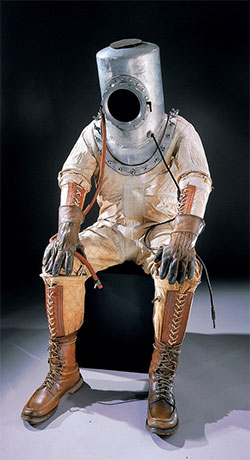 |
Near this time, Post was planning high altitude flights. Many Web sources show him dressed in his custom-made (by B.F. Goodrich) high altitude suit, right, resembling a deep sea diver. He intended to enter the McRobertson Race from London, England to Melbourne, Australia, in October, 1934. He did not compete. The article, left, from Popular Aviation (PA), November, 1934, shows engine modifications on the "Winnie May" [sic].
Early in 1935 he attempted several high altitude flights with little significant results except one. On March 15th, he planned to fly at 30,000 feet from Burbank, CA to New York. Post, equipped with his suit, a supercharged engine and jettisonable landing gear, departed Burbank mid-morning. At times he reached speeds of over 300MPH, illustrating the benefit of high flight.
Unfortunately, he was forced down in Cleveland, OH because he ran out of breathing oxygen. The photograph, below, from the Cleveland Public Library. Photograph Collection, shows the aftermath of the landing shortly after 5PM Cleveland time. To reduce drag, Post had jettisoned the landing gear soon after takeoff from California. He landed safely at Cleveland on a sturdy skid attached to the bottom of the fuselage. The only damage appeared to be smudges from flames from the exhaust caused by backfiring due to carburetor icing.
Regardless of the truncation, he established a new unofficial record for sustained flight, negotiating 2,044 air miles in 7 hours and 19 minutes for an average speed of 279.36MPH. Post estimated his top speed at 340MPN, which he maintained for about two hours.
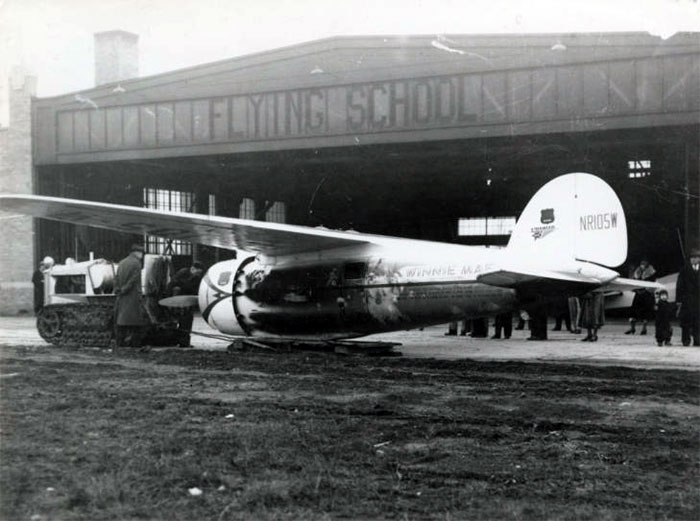 |
Alas, Post, with Will Rogers, were killed in a crash just four months later in Alaska on August 15, 1935. The NASM record for "Winnie Mae" states that a bill was introduced in Congress (H.R. 8622) on June 24, 1935 (preceding his death) to purchase NR105W at a price "not to exceed $25,000." The sale was completed after Post's death in cooperation with Mrs. Post. "Winnie Mae" was placed in the Smithsonian Institution where it remains today and the federal registration was canceled retroactively to August 15, 1935.
Another source for information about NR105W is the Lockheed aircraft page at the link.
---o0o---
SPONSORED LINKS
THIS PAGE UPLOADED: 09/21/14 REVISED: 06/20/19
